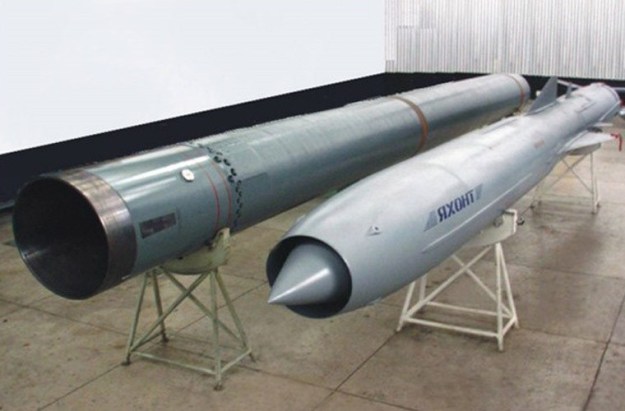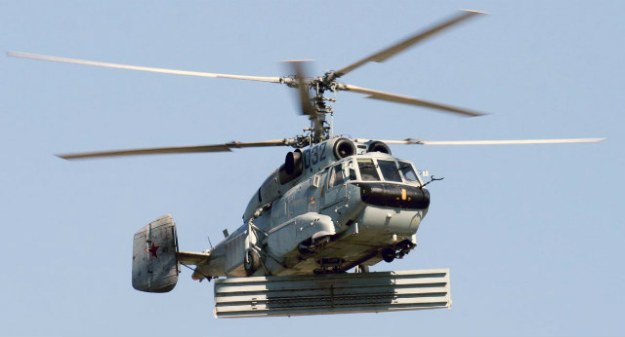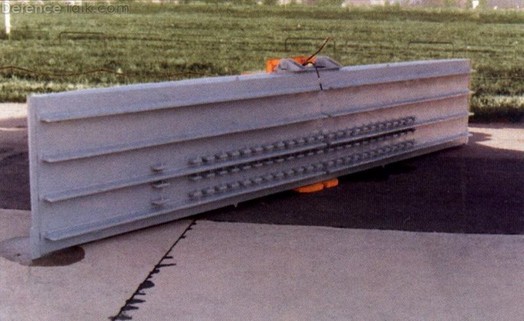The K-300P or Bastion-P is a Russian mobile costal defense missile system. The “P” letter in the designation denotes “mobile”. This coastal defense missile system is known in the West as SSC-5 Stooge. Development began in the 1990s.
The Bastion-P is in service with the Russian armed forces. First 3 systems were delivered to the Russian military in 2010. These are in service with the Black Sea Fleet. Latter one more missile system was delivered to the Black Sea Fleet and 2 systems to the Northern Fleet. This coastal defense system has been exported to Syria (2 systems) and Vietnam (2 systems).
Russian Black Sea Fleet to get Bastion coastal missile systems: Here
Russia to deploy missile systems on Kuril islands: Here
Bastion-P Costal defense missile system in Kaliningrad
 With 300 km range can control large parts of the southern Baltic Sea, for example from Kaliningrad. If you sit on Gotland will lock even more effective, as Karlis Neretnieks raised on Newsmill last week. – Image: oplatsen.wordpress.com
With 300 km range can control large parts of the southern Baltic Sea, for example from Kaliningrad. If you sit on Gotland will lock even more effective, as Karlis Neretnieks raised on Newsmill last week. – Image: oplatsen.wordpress.com
Source oplatsen.wordpress.com
Bastion-P Costal defense missile system in Crimea
The main role of the Bastion-P is to engage various surface ships. It can also engage carrier battle groups, convoys or landing craft. In some cases missiles fired from this system can target surface targets.
The Bastion-P launcher carries two P-800 Oniks/Yakhont (SS-N-26 Strobile) anti-ship cruise missiles. These have a range of 300 km with hi-low flight trajectory and 120 km with low-low flight trajectory. It is worth noting that the same missile was used as a basis for the BRAHMOS cruise missile.
The missile has a two-stage propulsion system. It uses solid-fuel rocket booster for initial acceleration and liquid-fuel ramjet for sustained supersonic cruise. The booster is ejected by the airflow after it has burned out.
The warhead weights about 200-250 kg. It seems that this missile can carry nuclear or conventional warheads.
P-800 Oniks/Yakhont (SS-N-26 Strobile) anti-ship cruise missiles
 SS-N-26 / 3M55 Oniks / P-800 Yakhont /P-800 Bolid – supersonic
SS-N-26 / 3M55 Oniks / P-800 Yakhont /P-800 Bolid – supersonic
3M55 Oniks/P-800 Yakhont/P-800 Bolid The supersonic P-800 Yakhont (Gem) is a ramjet version of P-80 Zubr [SS-N-7 Starbright]. The ship, submarine and coastal-launched Yakhont is launched from the unified ampoule-shaped transport-launching container (TLC). The container is 9 m long, is 0.71 m in diameter. The firing range reaches 300 km (162 nmi.) when flying along a combined trajectory and 120 kg (265 lb.) when following only a low-altitude trajectory. Flight speed varying over the range from M=2.0 to M=2.5 is provided by the kerosene-fueled multi-mode liquid-fuel ramjet. The P-800 Bolid is the encapsulated, submarine launched version of Yakhont. An air-launched version of the missile with the take-off weight of 2,500 kg (5,507 lb.) is also being developed. The closest American counterparts, the Tomahawk and Harpoon missiles, are subsonic; the best French antiship missile, the Exocet, has a range of only 45 miles. Source fas.org
| Country of Origin | Russia |
| Builder | Beriev |
| Role | Amphibious anti-submarine patrol aircraft |
| Range | 300 km mixed trajectory 120 km low trajectory |
| Speed | Mach 2 to 2.5 |
| Flight altitude | 5 to 15 meters, final phase |
| Weight of warhead | 200 kg [about] |
| Guidance | active-passive, radar seeker head |
| Minimum target detection range | 50 km in active mode |
| Maximum seeker head search angle | 45 degrees |
| Propulsion | · solid propellant booster stage · liquid-propellant ramjet sustainre motor |
| Launcher type | underwater, surface ship, land |
| Launch method | from closed bottom launch-container |
| Launch angle range | 15 to 90 degrees |
| Weight | 3,000 kg launch 3,900 kg in launch-container |
| Launch-container dimensions | 8.9 meters length 0.7 meters diameter |
 Image: npomash.ru
Image: npomash.ru
The fully charged and armed missile is stored in the sealed canister with compactly folded wings and fins. All routine checks can be conducted without missile removal from canister. Source npomash.ru

It is a fire-and-forget type missile. It uses a satellite guidance at the initial stage of the flight and active radar guidance when it approaches a target. This missile uses a Russian sea-skimming cruise missile technology. It can fly at altitude from 5 to 14 000 meters above the sea level. At the final stage of the flight it has minimum altitude. Also it can maneuver at supersonic speed before hitting the target. Close-in weapon systems might not be effective against this missile, as it travels too fast. Also this missile can be used in electronic countermeasures environment. So it might be a hard nut for air defense systems to intercept.





The launcher vehicle is based on a Belarusian MZKT-7930 heavy high mobility chassis (see bottom). Vehicle has good cross-country mobility and can operate over rough terrain. The TEL vehicle is operated by a crew of 3, including commander, operator and driver.


The Bastion Missile System: A Symbol of Power and Foreign Policy Tool: Here
Excerpt
The militarization of Russia has reached such an extent that not only its military force as such has become a foreign policy tool, but even individual weapons systems are also being used for this purpose. In recent weeks, the coastal defense missile system Bastion has acquired the role of a foreign policy tool. It denies the enemy access to a 600-km-long (372 miles) stretch of the coast, covering a maritime area of 150,000 sq. kilometers (57,915 sq. miles), and can defend the approaches to a political and administrative district as part of the latter’s joint defensive system.

The TEL vehicle can launch its missiles within 5 minutes from travelling. Vehicle has a vertical launch configuration. It can launch both missiles with short interval of 2-5 seconds between the launches. The missile can be used up to a Sea State 7.

The mobile launcher can remain on active standby over a period of 3-5 days. Once supported by a combat duty support vehicle, the Bastion-P launchers can remain on active standby for up to 30 days.
 Image: npomash.ru
Image: npomash.ru
A battery of Bastion-P consists of 4 mobile launchers, 1-2 command and control vehicles, 1 support vehicle; 4 transloaders. Launcher vehicles can be located up to 25 km away from the command and control vehicles. The whole Bastion-P battery is controlled from the main Naval headquarters. If required launcher vehicles can operate autonomously.

Also Russians propose additional over-the-horizon radar for the Bastion-P. A mobile version is based on the same MZKT-7930 8×8 high mobility chassis. Alternatively Russians their Ka-31 airborne early warning helicopter for this role.

Source roe.ru
Ka-31 airborne early warning helicopter
 Image: flightglobal.com
Image: flightglobal.com
The Ka-31 airborne early warning helicopter is based on the basic Ka-29TB. Originally this helicopter was known as the Ka-29RLD (Radiolokatsyonnogo Dozora, or radar picket helicopter). This AEW type was developed during the 1980s and first flew in 1988. It was first seen during trials aboard Kuznetsov aircraft carrier. Due to funding problems and political turmoil, caused by the collapse of the Soviet Union, the Ka-31 was officially adopted only in 1995. However it was fielded by the Russian Navy in very limited numbers. Later a small number of these helicopters have been exported to China and India.
The main mission of the Ka-31 is a long-range detection airborne and naval threats. This helicopter can track targets over much larger horizon than ship’s radars. It makes it an important completion for naval task force, whose ships are too small to operate carrier-borne early warning aircraft. In the Russian Navy the Ka-31 is mainly used on the Kuznetsov aircraft carrier and Sovremeny class and Udaloy class destroyers.
All four landing gear units are retractable, making space for the movement of the E-801E Oko (eye) surveillance radar’s antenna, which is a large rectangular planar array that rests flat under the fuselage when inactive.
E-801E Oko (eye) surveillance radar’s antenna
CAPABILITIES
–detection and identification friend-or-foe of low-flying targets in adverse ground and sea surface clutter (at sea states of up to 5-6);
–automatic target acquisition and measurement of target coordinates and motion parameters;
–target data output to external users
OPERATIONAL FEATURES
–fully automated operation of the radar: once the system is turned on, the antenna deployed and the operating mode selected, the operator’s role is limited to monitoring the condition of the hardware and observing the radar screen picture;
–the radar suite is equally well suited to operate from shipboard or a land base;
–built-in-test system
| Frequency band | L |
| Coverage: | |
| range | 7-250 km |
| altitude | 5-3.000 m |
| azimuth | 0-360 deg |
| Detection range against a fighter-type target | 100-150 km |
| Detection range against a sea surface target | within radio horizon |
| Range resolution | 500 m (worst case) |
| Simultaneously tracket targets | 40 |
| Date rate | 10 s |
| Turn-on time | 5 min |
| Antenna deploy-retract time | 80 s |
Source redstar.gr
Radar of the Ka-31 airborne early warning helicopter has a 360° coverage and can spot aircraft-size target from 150 km range. Surface ships are spotted from 100 – 200 km range. Radar can track 30-40 targets simultaneously. Helicopter has a datalink to transfer the target tracking data to the command post. The Ka-31 is fitted with GPS and digital terrain mapping systems.
| Country of origin | Russia |
| Entered service | 1995 |
| Crew | 2 men |
| Dimensions and weight | |
| Length | 12.5 m |
| Main rotor diameter | 15.9 m |
| Height | 5.6 m |
| Weight (empty) | ? |
| Weight (maximum take off) | 12.2 t |
| Engines and performance | |
| Engines | 2 x Klimov TV3-117VMAR turboshaft engines |
| Engine power | ? |
| Maximum speed | 250 km/h |
| Service ceiling | 3.5 km |
| Range | 600 km |
| Patrol radius | ? |
| Patrol endurance | 2 hours 30 minutes |
Ka-31 source military-today.com
MZKT-7930 8×8 high mobility chassis
The MZKT-7930 special wheeled chassis was developed in Belarus the early 1990s. Sometimes this vehicle is nicknamed the ‘Astrolog’. It was designed to replace the ageing MAZ-543 special wheeled chassis. The first prototype was completed in 1994. The MZKT-7930 was accepted to service with the Russian Army in the early 2000. Currently this special wheeled chassis is produced in small numbers.
The MZKT-7930 8×8 wheeled chassis has a payload capacity of 24 000 kg. It is mainly used to mount various weapon systems. This heavy load carrier is primarily designed for off-road applications.
A forward control cab of the MZKT-7930 accommodates driver and two passengers.
The MZKT-7930 is powered by a YaMZ-846 turbocharged diesel engine, developing 500 hp. For export customers it is proposed with a Deutz BF8M diesel engine, developing 544 hp, coupled with Allison automatic transmission. Vehicle has a full-time all-wheel drive and is fitted with a central tyre inflation system.
This high mobility vehicle is used as a chassis for the Iskander-E short range ballistic missile system and Bal-E costal defense missile system, TMM-6 heavy mechanized bridge and other applications. It also carries radar of the S-400 missile system. There is also an MZKT-7415 tractor truck.
| Entered service | 2000 |
| Configuration | 8×8 |
| Cab seating | 1 + 2 men |
| Dimensions and weight | |
| Weight (empty) | 20.5 t |
| Maximum load | 24 t |
| Length | 12.7 m |
| Width | 3 m |
| Height | 3.29 m |
| Mobility | |
| Engine | YaMZ-846 diesel |
| Engine power | 500 hp |
| Maximum road speed | 70 km/h |
| Range | 1 000 km |
| Maneuverability | |
| Gradient | 45% |
| Side slope | 30% |
| Vertical step | ~ 0.6 m |
| Trench | ~ 2 m |
| Fording | 1.4 m |
MZKT-7930 source military-today.com
Updated Sep 28, 2018





